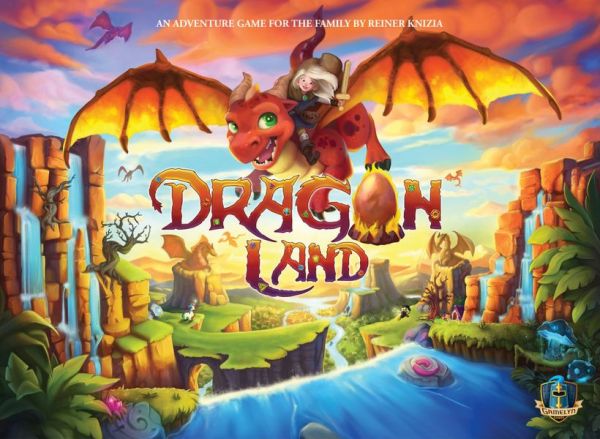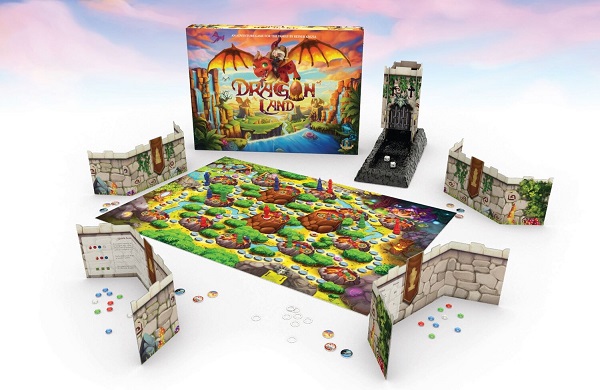Choose Your Treasures Wisely in Family Game Dragonland

Rescue eggs and gems from the erupting volcanoes, with the aid of dragon kings, witches, and unicorns!
Designed by Reiner Knizia (Lost Cities, The Quest for El Dorado) and published by Gamelyn Games, Dragonland is a family board game of set collection and dragons. Originally published in 2002, does this new edition still have what it takes to be fun for today's families?
Gameplay
Each player chooses a player shape, and takes three pawns of that shape in three different colors: red, green, and blue. You also start the game with three ability tokens. The board shows a number of volcanoes connected by paths. Each volcano has one-to-two dragon eggs, a certain number of gems, and a face-down ability token.
On your turn you roll two dice and then must assign each die to a different one of your pawns. You may move a pawn a number of spaces up to the number you rolled on the die assigned it (you can choose to move it zero spaces if you wish to leave the pawn at its current location). If your pawn reaches a volcano with a face-down token, it must stop its movement and you flip over the token. If a pawn ends its turn on a unicorn or witch space, you take a matching token if you do not already have one.
After your movement phase, if either pawn you moved that turn is on a volcano, you may collect a treasure there. You must choose which treasure you collect from those still there: a dragon egg, all the gems of your pawn’s color, a diamond gem, or the ability token. Any gem stones and eggs you collect you place behind your player screen, while you keep your tokens face up in front of it.
Some ability tokens are not taken from the volcano but are used rather than taking them. The king dragon tokens will only fly pawns whose color matches the dragon and you must have rolled a four that turn. Then the dragon will fly your pawn to any volcano on the board, the token moving with you. The ring token will place a ring on your pawn.
The other special ability tokens can be spent to do things such as allowing you to move between volcanoes connected by the river, reroll dice, move extra steps, or allow a single pawn to collect treasure twice. The unicorn can be spent to collect a gem of a color other than your pawn’s, while the witch lets you collect a gemstone from a volcano other than the one at which your pawn is currently located.
When the last dragon egg is taken the game ends. Players check each of their pawns. For each pawn you have who does not have a ring, you must discard all the gems you have collected whose color matches it. Then you check how many sets you have made.
Each set that includes a dragon egg and one gem stone of each color is worth ten points. The diamond gemstones act as wilds and can fill in for any color. Any additional stones and eggs not part of a set are worth one point. The player with the most points wins the game.

Review
Dragonland is a beautifully presented family game. While there is some luck in what you roll, the volcanoes are close enough together that you’re unlikely to go two turns without reaching one, and the tokens provide plenty of ways to mitigate the luck of the roll. Deciding which volcanoes to head for is also an important choice, and there are three entrances to the board players can choose to start their pawns on.
The treasure collecting phase provides plenty of great choices as well, as you choose between gems, eggs, or those tokens that will help you if you hit some bad rolls. The need to collect rings if you want certain colors of gems to score also provides an extra layer to both the choices and the scoring. Do you want to try for all three rings? Or do you want to collect diamonds to fill in the gap and instead focus on collecting more of other colors and tokens?
There is no direct player interaction, however the player screens keep play suspenseful. You might think you know how many points the other players are holding but you can’t be sure, and this can change how you feel about using a turn to collect tokens or going for the rings.
Dragonland is bright and colorful and the board looks gorgeous. All the components are nice quality and likely to appeal to its audience, although not all the shapes of the player pieces are easy to distinguish from each other at a glance. It would also be useful if the player screens had descriptions of each token type’s special ability. Additionally the dice tower doesn’t fit in the box when built, so you do have to put it back together each time you want to play with it (it’s definitely not a necessary component although it looks lovely), and setup of the game does take a little while.
It isn’t something that adult game groups are likely to want to play, but as a family game Dragonland has plenty to keep everyone interested. It’s strategic without being too complex, has a simple yet interesting scoring system, and is easy to learn. Plus, it’s just a treat to behold.
Pros: Gorgeous aesthetics that are likely to be a hit with families, interesting player choices, ability to mitigate luck
Cons: Set up takes some time, player pieces can be difficult to tell apart, no player aids for token abilities
Disclosure: we received a complimentary review copy of this game.







